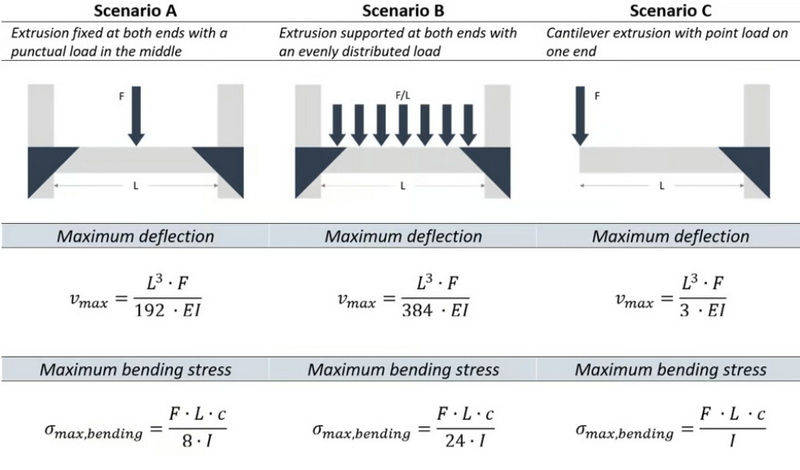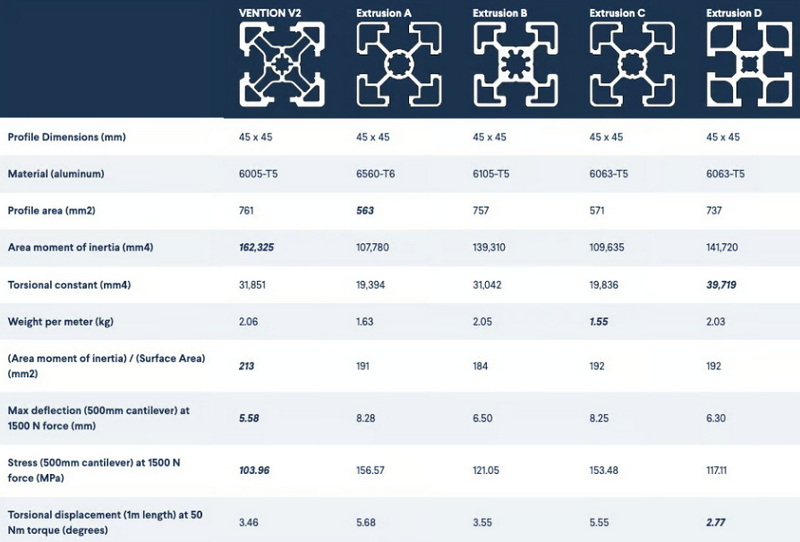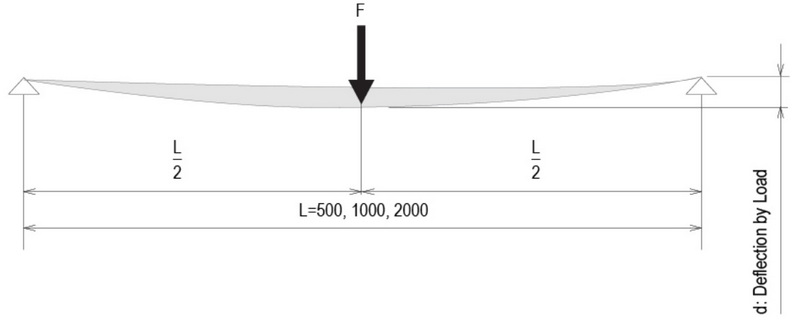Content Menu
● Understanding Aluminum Extrusion
● Factors Affecting Aluminum Extrusion Load Capacity
● Calculating Aluminum Extrusion Load Capacity
● Maximizing Load Capacity in Aluminum Extrusion Design
● Real-World Applications and Load Capacity Examples
● Testing and Verification of Load Capacity
● Innovations in Aluminum Extrusion Technology
● Environmental Considerations and Sustainability
● Future Trends in Aluminum Extrusion Load Capacity
● Conclusion
● Frequently Asked Questions
>> 1. How does the load capacity of aluminum extrusions compare to steel?
>> 2. Can the load capacity of aluminum extrusions be increased after production?
>> 3. What safety factors should be considered when designing with aluminum extrusions?
>> 4. How does temperature affect the load capacity of aluminum extrusions?
>> 5. What are the best practices for joining aluminum extrusions to maintain load capacity?
● Citations:
Aluminum extrusion is a versatile and widely used manufacturing process that produces profiles with exceptional strength-to-weight ratios. One of the most critical factors in designing structures and components using aluminum extrusions is understanding their load capacity. This article will delve into the intricacies of aluminum extrusion load capacity, exploring the factors that influence it and providing insights into how to maximize the strength of your designs.

Understanding Aluminum Extrusion
Before we dive into load capacity, it's essential to understand what aluminum extrusion is and how it's produced. Aluminum extrusion is a process where heated aluminum billets are forced through a die to create profiles with specific cross-sectional shapes. This process allows for the creation of complex shapes with consistent properties along their length.
The resulting profiles can be used in a wide range of applications, from construction and automotive to aerospace and consumer goods. The versatility of aluminum extrusions lies in their ability to be designed for specific load-bearing requirements while maintaining a lightweight structure.
Factors Affecting Aluminum Extrusion Load Capacity
Several factors influence the load capacity of aluminum extrusions:
1. Alloy Composition: Different aluminum alloys have varying strengths. Common extrusion alloys like 6061 and 6063 offer a good balance of strength and extrudability.
2. Profile Design: The cross-sectional shape of the extrusion significantly impacts its load-bearing capacity. I-beams, for example, are designed to resist bending, while tubular profiles offer good torsional resistance.
3. Wall Thickness: Thicker walls generally result in higher load capacities but also increase weight and cost.
4. Heat Treatment: Post-extrusion heat treatments can enhance the mechanical properties of the aluminum, improving its strength and load-bearing capacity.
5. Length and Support: The span between supports and the type of support (e.g., fixed or simply supported) affect the maximum load an extrusion can bear.
Calculating Aluminum Extrusion Load Capacity
Determining the exact load capacity of an aluminum extrusion involves complex calculations that consider various factors. However, a simplified approach can give us a general idea:
1. Bending Stress Calculation:
σ = M / Z
Where:
σ = Bending stress
M = Bending moment
Z = Section modulus
2. Deflection Calculation:
δ = (P * L⊃3;) / (48 * E * I)
Where:
δ = Deflection
P = Applied load
L = Length of the beam
E = Modulus of elasticity
I = Moment of inertia
It's important to note that these calculations provide theoretical values. In practice, safety factors should be applied, and real-world testing is often necessary to validate designs.
Maximizing Load Capacity in Aluminum Extrusion Design
To optimize the load capacity of aluminum extrusions, consider the following strategies:
1. Choose the Right Alloy: Select an aluminum alloy that offers the best combination of strength and extrudability for your application.
2. Optimize Profile Design: Use finite element analysis (FEA) to design profiles that efficiently distribute loads and minimize stress concentrations.
3. Incorporate Reinforcements: Add internal webs or ribs to increase the moment of inertia without significantly increasing weight.
4. Consider Composite Solutions: In some cases, combining aluminum extrusions with other materials like carbon fiber can dramatically increase load capacity.
5. Utilize Heat Treatment: Post-extrusion heat treatments can significantly enhance the mechanical properties of the aluminum.
Real-World Applications and Load Capacity Examples
Let's explore some common applications of aluminum extrusions and their typical load capacities:
1. Structural Framing: In construction, 4" x 4" aluminum extrusions can often support loads of several thousand pounds, depending on the span and configuration.
2. Conveyor Systems: Aluminum extrusion conveyor frames can typically handle distributed loads of 100-200 lbs per linear foot.
3. Solar Panel Mounting: Aluminum rails for solar panels are designed to support the weight of the panels plus wind and snow loads, often exceeding 50 lbs per square foot.
4. Automotive Components: Aluminum extrusions in car frames can withstand crash forces of several tons while maintaining passenger safety.
5. Aerospace Structures: In aircraft, aluminum extrusions are used in wing spars that can handle loads of tens of thousands of pounds during flight.
Testing and Verification of Load Capacity
While theoretical calculations are essential, real-world testing is crucial to verify the load capacity of aluminum extrusions. Common testing methods include:
1. Three-Point Bending Test: This test measures the flexural strength and stiffness of the extrusion.
2. Tensile Testing: Determines the ultimate tensile strength and yield strength of the material.
3. Fatigue Testing: Assesses the extrusion's ability to withstand repeated loading cycles.
4. Impact Testing: Evaluates the material's resistance to sudden loads or impacts.
Innovations in Aluminum Extrusion Technology
Recent advancements have pushed the boundaries of aluminum extrusion load capacity:
1. Micro-Alloying: Adding small amounts of specific elements can significantly enhance the strength of aluminum alloys.
2. Advanced Die Design: Computer-aided design and simulation allow for more complex and efficient extrusion profiles.
3. Friction Stir Welding: This solid-state joining process enables the creation of larger, more complex structures with improved strength.
4. Nano-Structured Aluminum: Manipulating the grain structure at the nanoscale can dramatically increase the strength-to-weight ratio.

Environmental Considerations and Sustainability
When discussing aluminum extrusion load capacity, it's important to consider the environmental impact. Aluminum is:
1. Recyclable: Nearly 75% of all aluminum ever produced is still in use today, thanks to recycling.
2. Energy-Efficient: Recycling aluminum requires only 5% of the energy needed to produce new aluminum.
3. Lightweight: The high strength-to-weight ratio of aluminum extrusions contributes to fuel efficiency in transportation applications.
4. Durable: The long lifespan of aluminum structures reduces the need for replacement and conserves resources.
Future Trends in Aluminum Extrusion Load Capacity
Looking ahead, several trends are likely to shape the future of aluminum extrusion load capacity:
1. AI-Driven Design: Artificial intelligence and machine learning will optimize extrusion profiles for specific load requirements.
2. Additive Manufacturing: 3D printing of aluminum parts may complement traditional extrusion for complex, low-volume components.
3. Smart Materials: Integration of sensors and adaptive materials may allow for real-time load monitoring and response.
4. Hybrid Structures: Combining aluminum extrusions with other materials like composites or high-strength steels may create ultra-high-performance structures.
Conclusion
The load capacity of aluminum extrusions is a critical factor in their widespread use across various industries. By understanding the factors that influence load capacity and employing proper design techniques, engineers and designers can create structures and components that are both lightweight and incredibly strong. As technology advances, we can expect to see even greater improvements in aluminum extrusion load capacity, opening up new possibilities for innovative applications.
The versatility, strength, and sustainability of aluminum extrusions make them an ideal choice for many load-bearing applications. Whether you're designing a simple frame or a complex aerospace component, understanding and optimizing aluminum extrusion load capacity is key to creating efficient, durable, and high-performance solutions.

Frequently Asked Questions
1. How does the load capacity of aluminum extrusions compare to steel?
Aluminum extrusions generally have a lower load capacity than steel of the same size. However, when considering the strength-to-weight ratio, aluminum often outperforms steel. This makes aluminum extrusions particularly advantageous in applications where weight is a critical factor, such as in aerospace or automotive industries. Additionally, aluminum's corrosion resistance and ease of fabrication can make it a preferred choice in many scenarios despite its lower absolute strength.
2. Can the load capacity of aluminum extrusions be increased after production?
Yes, the load capacity of aluminum extrusions can be enhanced post-production through various methods. Heat treatment is one of the most common approaches, which can significantly improve the mechanical properties of certain aluminum alloys. Additionally, surface treatments like anodizing can increase hardness and wear resistance. In some cases, reinforcing existing extrusions with additional components or combining them with other materials can also effectively increase their load-bearing capacity.
3. What safety factors should be considered when designing with aluminum extrusions?
When designing with aluminum extrusions, it's crucial to apply appropriate safety factors to account for uncertainties and ensure structural integrity. Typical safety factors range from 1.5 to 2.5, depending on the application and industry standards. Factors to consider include:
- Variability in material properties
- Potential for impact or dynamic loading
- Environmental conditions (temperature, humidity, corrosive environments)
- Fatigue and cyclic loading
- Manufacturing tolerances and potential defects
Always consult relevant industry standards and regulations when determining safety factors for your specific application.
4. How does temperature affect the load capacity of aluminum extrusions?
Temperature has a significant impact on the load capacity of aluminum extrusions. As temperature increases, the strength of aluminum generally decreases. At elevated temperatures (above 200°C or 392°F), aluminum can experience significant softening, which reduces its load-bearing capacity. Conversely, at very low temperatures, aluminum becomes stronger but may also become more brittle. It's essential to consider the operating temperature range when designing with aluminum extrusions and select appropriate alloys or implement thermal management strategies for high-temperature applications.
5. What are the best practices for joining aluminum extrusions to maintain load capacity?
To maintain the load capacity of aluminum extrusions when joining them, consider the following best practices:
1. Use mechanical fasteners designed for aluminum, such as self-tapping screws or bolts with appropriate washers.
2. Employ welding techniques suitable for aluminum, like TIG (Tungsten Inert Gas) or MIG (Metal Inert Gas) welding, ensuring proper filler material selection.
3. Consider adhesive bonding for certain applications, using epoxies or structural adhesives designed for aluminum.
4. Utilize specialized connection systems designed for aluminum extrusions, such as T-slot connectors or gusset plates.
5. Avoid galvanic corrosion by using compatible materials or incorporating appropriate isolation methods when joining aluminum to dissimilar metals.
Always test joined assemblies to verify that the desired load capacity is maintained after joining.
Citations:
[1] https://us.misumi-ec.com/pdf/fa/2010/p2433.pdf
[2] https://www.shengxinaluminium.com/blog/industrial-aluminum-extrusion-profile-load-bearing-calculation_b46
[3] https://www.tuli-shop.com/blog/aluminium-profile-load-capacity.html
[4] https://th.misumi-ec.com/en/pdf/fa/2014/p2_513_519_521_523_525.pdf
[5] https://vention.io/resources/guides/t-slot-aluminum-extrusion-structure-design-guide-77
[6] https://www.yjing-extrusion.com/how-much-weight-can-2020-aluminum-extrusion-hold.html
[7] https://www.hugh-aluminum.com/how-strong-is-2020-aluminum-extrusion/
[8] https://www.pbalm.com/calculation-of-allowable-load-of-profile.php
[9] https://anglelock.com/blog/how-much-weight-can-aluminum-extrusion-hold/






















